Araucaria heterophylla
Family: Araucariaceae Origin: Norfolk Island
People in climates where this tree can’t be grown outside (most notably in the US) grow what they think are Norfolk Island Pines in pots in their homes. Unfortunately, they’re usually mistaken. What is mostly available as a houseplant is actually the Cook Pine (Araucaria columnaris). But for the folks living in temperate, tropical areas, true Norfolk Island Pines grace suitable growing areas and are certainly sights to behold. Not technically a pine tree scientifically speaking, this tree’s overall appearance and form still lend it to look very pine-esque, especially when young.
This species is labeled as “vulnerable” and is a threatened species in its native island of Norfolk Island due to heavy harvesting in the past few hundred years. Protective measures have been taken to protect what’s left of this tree in its endemic homeland.
Arboriculture
Growth Form
Norfolk Island pines have a monopodial growth form, like most conifers. That is, they have a single trunk from which branches grow. The growth form is caused by strong apical dominance, growth occurring mainly towards the tip of the trunk.
As mentioned above, when this tree is young, it looks very much like a pine tree. Perfect triangle silhouette with evenly spaced branches, this tree looks great even when most other coastal trees that it shares its native home with are twisted and mangled by prevalent winds. They grow tall at maturity, around 65 metres when mature.
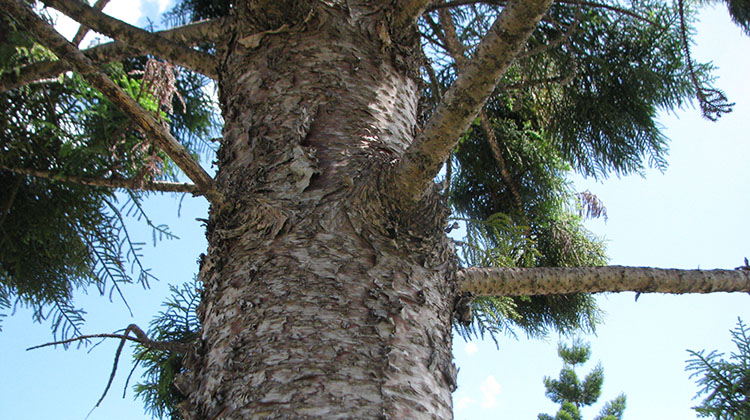 Trunk
Trunk
Single thin trunks are vertical and tall, which made them valuable as masts for ships during early colonization of the island. Unfortunately, it was found they had a tendency to break, which lowered their value somewhat.
Foliage
Young trees have different shaped leaves from older trees. When young, the leaves are awl-shaped, about a centimeter long and overlap each other in whorls on stems. Older trees have incurved 5-10mm long needle like leaves. Thicker leaves that look like scales form in the upper crown of the tree.
Cones
Although Norfolk Island pine trees are not actually pine trees, they are still conifers. They bear woody cones similar to most pine trees in that they open out to spread their seeds while still on the tree.
Another misnomer, and one they also share with pine trees, is their cones being called male and female flowers. Conifers do not bear flowers. They branch off, on the phylogenic tree, specifically because they do not bear flowers (gymnosperms rather then angiosperms). There cones do, however, have male and female gender. Being on different trees, they are dieocious, though there are occasional trees which are not.
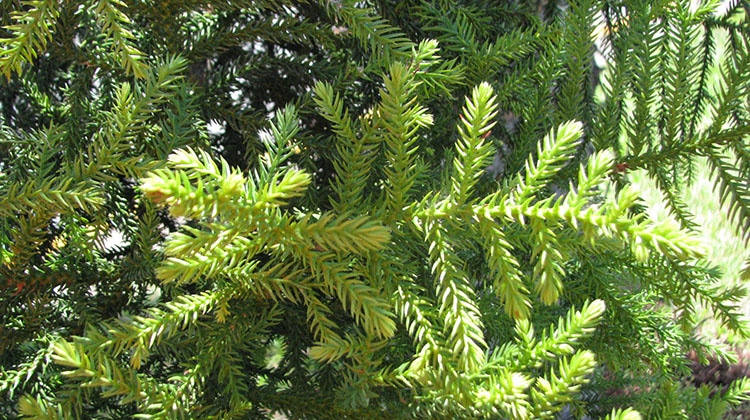 Fruits
Fruits
Female flowers give way to squat globe-shaped cones that are about 12cm long and 14cm wide. They take 18 months to mature, and then they disintegrate and release edible seeds that look like nuts.
Management
Propagation
Many of these trees are started from clippings for pot culture, but this method also works for landscape plants. Take 2-3 inch new growth stem cuttings and root them in rooting medium. Keep them warm and moist until they form roots. They can also be started from seed.
Cultivation
While highly adaptable to different climates, this tree does especially well in areas where many other trees do not. Adapted to marine winds, this tree relies on the salty spray from ocean winds. It requires nutritionally lacking deep sand for soil. They require constant moisture without standing water. They don’t do well in very high winds, but do fine in consistent ocean breezes and some moderate winds.
In Brisbane, Norfolk Island pines are fine without added amendments to soil, but young trees do benefit from some added fertilizer to help new growth after a few weeks of being planted. Protect new seedlings for a year or two after transplant from high winds and sun that’s too direct. After establishing, this tree needs relatively no care.

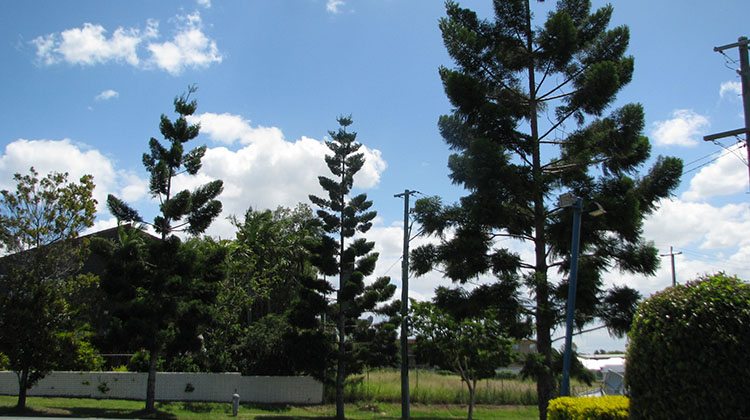
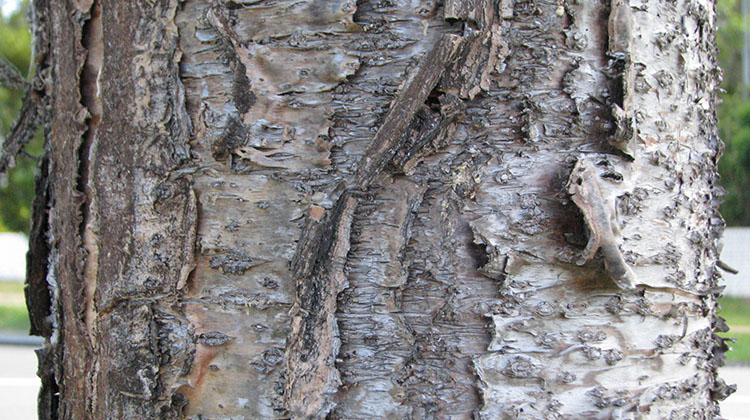
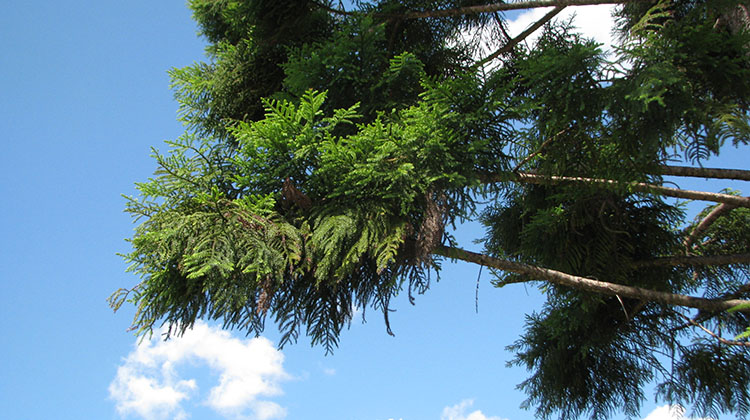
Hi David, I am wanting to plant a NIP in our front yard here on the Mornington Peninsula in Victoria as we absolutely love these trees.
I’m quite concerned about the size they can reach and I’m considering planting one in a large plastic container in the ground to limit its growth (to 10m or so hopefully).
I plan to use something like a plastic 44 gallon drum or even a 1000L IBC, do you think this will work to limit the tree’s size without adversely affecting it’s health?
Hi David, a great post – thanks.
I was wondering about two things. First, it looks like the trees in photos above are Hoop Pines, is this incorrect? Or is the name synonymous… I know originally the two were interchangeable. Secondly, our house is the original on Melbourne’s Mornington peninsular and is accompanied by a hoop pine planted c1854. Would you be able to answer some questions about it re tree health or is this site dedicated to Norfolk pines (in their true form?) only.
Cheers mate, let me know
Hi David, I have a couple of star pines for over 2 years started from cuttings but they are not growing the trunk except branches, what’s the problem?
Hi Nicholas, I also live on the Peninsula and I’m considering planting one of these beautiful trees in our front yard, although I’m concerned about how close I can place it to our house.
I’d love to see your’s one day, being that old they must be enormous?!?
Hi there.
This is the second year in our house and the neighboring yard has a NIP that sheds thousands of seeds this summer (Brisbane).
I can’t recall this happening last summer…is it a bi-annual event?
Cheers
Mick
Hi there David,
I have a Norfolk pine in my back yard in Brisbane which has grown well above the house maybe double. It’s near the back corner of 2 other properties, which so far is no problem. Some of my questions have been answered on this blog which is great.
The tree has a slight curve at least half way up.
It lives next to a very large palm which may have directed its growth or the the gap storms redirected its growth.
My question is which is more likely ?
You mentioned bromiliades to grow under neath. I have built up a mound of soil away from the truck and planted lavender. It’s working so far. Good or bad ?
Thanks Frances.
Hi David, there are 10 or more Norfolk Island pines growing close to the beach where I live in northern NSW. They range in size and age the oldest being 100 years old and very tall. They look striking where they are and are part of the history of the beach. My concern is the local council plan to dig a 200m long sewage trench into the top of sand dune where the 140,000 litres a day of chemically treated sewage water will flow down the sand dune via all of the Norfolk Island Pines to the beach. I am concerned what that large volume of water will do the pines. If it weakens their root systems will the pines fall? How do these pines cope with wet roots? I haven’t been able to find any specific information online. We want to stop this sewage proposal in its tracks but I need some facts as to the effect on the historical pines.
Many thanks for your help
Melissa
I live in Victor Harbor and Council has planted so many Norfolk Island pines that we can’t see the Beach! Birds don’t nest in them and humans don’t lay down under them, and there’s a saying that we have more pines here than on Norfolk Island…ls there an estimate of how many there are there?
Hi Mark
I was born and raised in victor harbor! I love the fact they have planted so many pines! Especially along the esplanade. They are truly spectacular! I recently moved to Perth and I’m renting a house which out the front stand two huge Norfolk island pines. Takes me back to my childhood and I quite like them! Birds do nest in them I have two nests in one tree. We have many crows and other birds in them! They bring a lot of different wildlife to my yard. Good luck trying to get them to stop planting the pines! they have been doing it for many years. Sorry about the view that’s such a pitty. where are you located? Did they have pines blocking the view before you moved in?
Magpie nests, currawong nests, whitefaced heron nests, osprey nests make our Caloundra Norfolks prime avian real-estate.
Hi, We are on the east coast of Australia. There is a 40 year old massive Norfolk Island pine in the suburban small yard next to our block that I am very worried about. It is far too big for the block and takes up most of the back yard. Earlier in the year it was struck by lightening and it is now dead. Unfortunately it is west of us and every time we get a westerly wind It drops its dead spines all over our roof and yard.
My real concern is that this tree will fall on our house during one of these westerly winds/storms. If it did it would flatten our home and could be deadly to us.
Should I be worried?
Lee
Hello David …I have a HUGE Norfolk Island Pine I love it. I clean up all the dropped fronds all the time… It must be 35 years old … However this year it has dropped seeds constantly … I have cleaned up neighbours across the roads lawn also the road where we live.. It is getting beyond me and so much work as we are not young anymore. My husband says it must be chopped down . We live on a coastal area in WA… This is the first time that it has dropped all these seeds…. How often does this happen . I am getting very frustrated with it . Plus the fact it is going to cost a fortune to remove… It gives my house and garden a lot of shade in the summer which i love . It is very windy here and those SEEDS are unbelievable so many WHEW
get rid of it .
I would be happy to uy some seeds
Mine is about 35 hrs old also and this year during a storm thousands of the little cone discs covered my roof, yard, pool and gutters. (Florida)
Hi David
Could you please explain how the root system of a Norfolk pine works? I’ve heard they have surface roots and tap roots but haven’t been able to find anything that explains it definitively. I’m also interested in understanding how the root system establishes and changes over the life of the tree – particularly what it might look like for a 60-80 year old tree. I understand there is a formula to work out how far away from the tree is safe/safer to remove surface roots – is that true and if so, could you please advise what it is? Thank you very much.
In which direction does the Leaf/ fond system grow? up? or down.
Hi,
We have a Norfolk pine about 6 meters from our front porch, it’s about 50 meters high if not more. The base is huge about the width of a car. It is a beautiful majestic tree however right now we are in a storm with 125km winds and I’m unable to sleep wondering if this will fall. Everyone I’ve spoken to says it wont fall but my anxiety is kicking in. I have 2 children in the house and have moved us to the back rooms just in case.
What are the chances this could fall and are they heavy tree. Will my house become rubble pile if it falls.
Thanks in advance jenna
Hey Jenna I wouldn’t be worried about your Norfolk falling down at all I live in Esperance WA and our beautiful town is littered in big 100yr old pines , and iv never even seen a branch come down! , cheers
Hi, just found this site looking for information. I have an extremely tall Norfolk pine growing close to my house and the neighbours. We are on a hill so the yard is sloped. An arborist said the tree is healthy, but I am worried of damage it could do if it did fall and the cost. I am also worried for our backyard as the tree root system is helping keep it together (eroding further down) and if I get rid of it the ‘slope’ will end up in a neighbours back yard. What should I do?
Hi David, I just came across your article when researching if a Norfolk pine will withstand heavy pruning. Recently our beautiful established pine was mistakenly pruned while we were not at our holiday house in Mollymook (south coast NSW). The horizontal branches have been cut half way along their length on the bottom 2/3 of our tree. I’m heartbroken. Can the tree survive a prune like this. I don’t know what I should do. Any information on this would be much appreciated
Vanessa
Hi David
I have 2 x 15-20 metre at least pines. After a ferocious storm in Mooloolaba, on the weekend 1 lost 3/4 of the branches, damaged the neighbours roof with multiple spear like debri. I have made a decision to remove the trees. It is not an easy decision.
I need to know by Thursday if it is safe to cut the stumps to 3 metres high so I can place a possum home at the top and attach my passionfruit vine to a height to 2 m. It seems like a good opportunity to utilize the stumps in the garden as upright poles. Yes or no? It would give me pleasure to what is a sad occasion.
Your information would be gratefully received.
Cheers Larissa
Hi Larissa. They are likely to regrow, and if so will require management of the regrowth as the new branches will be weaker than the original ones. If you have the stumps poisoned then termites are likely to be your biggest concern.
So glad to have found this site. In regards to Norfolk Pines, we live in a street lined with 100 year old trees on the WA Midwest coast. They are looking healthy but in the past weeks large, green branches laden with new, green cones have been dropping from various trees. We do have high coastal winds, with particularly gusty days lately and a drier than normal winter. . Have never seen this before in the 25 years we’ve lived near them. What could be happening?
I live in Los Angeles CA, I have a HUGE Norfolk pine in my back yard. I have lived here for over 30 years and it has grown quite a bit. But this year for the first time ever it is constantly dropping seeds – for months now. My whole yard is buried in them. Is this normal? Is the tree dying and desperately trying to reproduce before it dies?? (it has also been losing bottom branches and has had sap dripping on one side (where lts of branches have fallen) This drip area has been creeping up the trunk for over twenty years and I cannot find any bug holes. It is otherwise healthy.
You will need to engage a local consulting arborist to visually assess the tree, Lore. They will be familiar with local conditions and pests. You might find answers just from phoning a consulting arborist. I recommend looking for an ISA Certified arborist with the ISA Tree Risk Assessment Qualification.
Hello David, We have a Norfolk Pine in the street 1.5 metre from our boundary and Council “water meter ” the tree is 60 metres high, consequently, the root zone has invaded our property and damaged the “water Service ” which has run up a “water bill” .
The ” Central Coast Council ” legal department denies responsibility and is demanding we pay $800 water excess. Do you think this is reasonable ?
Regards, Phil.
Hi Phil. No, it doesn’t sound reasonable at all. If the situation will be on-going you might consider contracting a consulting arborist to report on the tree roots.
Hi
Any ideas on a species of birds that loves hanging out in Norfolk island pines? We have a bird that hangs out in our neighbors tree and just sitting at a bus stop 6 km away n can hear the same bird song in another tree.
Really beautiful song. Any ideas anyone??
Just came across this post. I assume it depends where you live. I have seen American Kestrels, Cooper’s hawks, mockingbirds, doves, loggerhead shrikes, bluejays, grackles, starlings, a fish crow, and what I think was an immature oriole on mine. Because of the height of the tree it seems to be favored by birds of prey, hawks and kestrels.
Down at Tuross there are some Norfolk Pines a few doors down that house kookaburras, cockatoos and other parrots. It is nice to hear their bird noises.
I’m actually very concerned about the spread of Norfolk Island Pines in Australia. I’m a huge fan of Hoop and Bunyas when they’re planted in their native ranges, but anything else is a no go for me. Especially when you look at all of our beautiful beaches (at least those where there are townships), the Norfolk Pine has absolutely destroyed the aesthetic of our coastline. What happened to native Casurinas and Mellalucas, Banksias with colour birds and the tropical pandanus palms…. I don’t understand how anyone can be okay with planing rows of towering introduced trees. The last thing I’d want to see at the beach are Christmas trees…
I actually agree with you completely. If I had it my way I’d probably have them all removes – all but a few of the oldest specimens – and use the reclaimed space to properly revegitate the area!
Sorry mate I disagree as much as I love species staying endemic. Not gonna happen in this day and age mate. Conifers are the best plants in my opinion and the Norfolk Island pines along our coastline look awesome 👍
The only reason it wouldn’t happen is thanks to people like you who resist positive change due to selfish sentiments. I don’t personally see what you find so “awesome” about them. If you want a chritmas tree on the beach, go to Norfolk Island, or Washington State. Why do some people try so hard to make Australia look like a different place.. rather than embracing the unique natural identity of the region. It’s like how in Melbourne they’ve planted oaks and Chinese elms.. to me it’s madness. Sure they’re beautiful, as is every tree, but there’s a place for them, and it’s not Australia. Just as there isn’t a place for NIPs along the coasts. They offer no aesthetic or environmental benefit.
The only reason it wouldn’t happen is thanks to people like you who resist positive change due to selfish sentiments. I don’t personally see what you find so “awesome” about them. If you want a Christmas tree on the beach, go to Norfolk Island, or Washington State. Why do some people try so hard to make Australia look like a different place.. rather than embracing the unique natural identity of the region. It’s like how in Melbourne they’ve planted oaks and Chinese elms.. to me it’s madness. Sure they’re beautiful, as is every tree, but there’s a place for them, and it’s not Australia. Just as there isn’t a place for NIPs along the coasts. They offer no aesthetic or environmental benefit.
Hi David. Thank you for your information. I have 3 beautiful large Norfolk Island Pines on my property in Brisbane, and would like to landscape under them. Can you tell me what plants would grow best there, or what to avoid? Thanks
Hi David, thanks for the article. Araucarias are fascinating trees. I do have a question though, one that comes from the fact that A. heterophylla gets frequently confused with A. columnaris (Cook “pine”) in my neck of the woods: is there a way to tell the seeds of these two species apart? Or is there a way to tell the seedlings apart when they sprout? I read somewhere that A. columnaris’ seedlings have narrower cotyledons, but 1. I don’t know if I can trust the source and 2. it didn’t provide any A. heterophylla seedling images for comparison. There are heaps of Cook pine images online (both seeds and seedlings) but comparatively few Norfolk Island pine images, and many of those are clearly Cook pines anyway.
hi all, I have now found info on Norfolk pine roots – no deep tap root. After recent vey high winds and us moving out for the night just in case, I at last found it has a shallow root system, and the site said it is prone to being blown over. We now estimate the tree is 15 metres tall and still growing. It is in very sandy soil and is less than 2 metres from my house. If it falls it will kill anyone in its path., A couple of intense storms ago 2 branches fell – just the branches were huge and heavy.
A level 5 arborist said I should not worry just have insurance – and if my time (to die) has come – it has come. He said the roots are shallow and in sandy soil have ‘sinkers roots’ spreading downwards from the shallow wide root system searching for nutrients. I asked re thinning out the branches at the top or lopping the top (its ugly but safety trumps aesthetics for me) to make it less prone to tipping over but he advised this could weaken the tree and cause it to fall.
my question: can an arborist give me a second opinion of the risk of this falling and any negative impact of thinning out the branches? I have searched intensely for examples of falling Norfolk pines but found nothing – may be my flawed search criteria. .
many thanks
Hi Liz
I’ve been involved in the post-mortem of two Norfolk Island pines complete failures (that is, uprooting). Both trees were perhaps 100cm dbh and probably over 25m tall. One other large A. heterophylla had to be removed due to a fungal pathogen that had an entry point due to multiple branch failures.
I’ve never seen a smaller tree of this species fail. Nevertheless, individual site factors play an important role so you were right in having your tree inspected.
If you have branches removed by a qualified arborist you are unlikely to risk infection by pathogens, though tree loppers may prune the branches incorrectly and permit fungal entry at wound sites. But, why do you want it thinned out? Is it to reduce windage? Because that would largely be offset in a tree with this particular growth form by reduced strength as the branches absorb impact from the wind strengthening the trunk.
I can give you a second opinion if you are in Brisbane but it’s unlikely my opinion would differ from your current information if you have used a competent level, 5 arborist, as we all rely on the same science.
hi David
thank you so much for your prompt reply.
I thought trimming it would reduce the weight at the top of the tree and therefore cause less swaying and so less prone to falling.
But your answer explains why the tree would be weakened if I trim it. – a risk for fungal entry thereby weakening the tree, and thinning out branches would mean the branches do not absorb the wind energy and instead the trunk would? So from the sound of it I am best off to cut the top outright with a certified arborist who would ensure it is cut properly and no fungal entry is possible? I hate the idea of making it ugly though. I know I can remove the tree as its so close to my house but I love its look shade, and home to large birds during nesting.
What time of the year do you harvest Norfolk pine seed please reply is needed regards
Hi Martin. It depends where you are located. In Brisbane, it’s supposed to be from January to May (late summer to the end of autumn) and the seeds are already breaking out of the cones in Brisbane. I picked up a half-empty cone yesterday. Every fourth or fifth year there is very low cone production. It’s part of a natural cycle so quite normal. Regards, David.
Hello
Perhaps I am very intusive, but is it possible to get 30 seeds from this tree?
You make me happy.
Thank you very much for your help
Hi Ton, Sorry, The Netherlands prohibits imports of seeds. Regards, David.
I cannot find any information online on the root system of my norfolk pine tree. It is now extremely tall and the trunk is now 3.100 centimetres in circumferance. . I am confident if I try to build a hole for a pool a metre and a half from the trunk it will mean some of the root system will be destroyed. People tell me it has a deep tap root – but I cannot find confirmation of this anywhere. It is still growing. . Are you able to assist me with information re the roots please?
Hi Liz. Do you mean its circumference is 3.1m? That would give you a diametre of just under 1 metre. The structural root zone (SRZ) of the tree is calculated using a fairly complex formula using the diameter of the tree just above the roots. Supposing it was 1m, your structural root zone would be 3.3m. No arborist should suggest it safe for you to excavate that close to the tree without compromising the structural integrity of the pine. If they have, please phone me immediately on 0488 827 267. Thanks, David.
thank you David – I have left you a voicemail and sent you some footage of the excavation next to my tree
kind regards
Liz Binet
Putting a pool that close to any established medium to large tree will result in sinificant damage to the tree, and potentially in future the pool
Hi David,
I have a very tall Norfolk Pine hard up against the House footing. Is continuued root growth going to be a problem. The tree is about 9 metres tall.
Cheers,
Jill
Hi Jill. It’s not just the continued growth of your tree’s roots that will be a problem, the current roots under the footings will also be an issue. During dry weather roots contract leading to soil subsidence. How much of a problem it will be depends on your soil type: re-active clay being the worst. The tree is, unfortunately, in the wrong place.
Also, if roots that close to the trunk were cut during excavation then your tree is not stable.
Is there any preparation needed for the Norfolk pine seed,/nut or do you just perl husk and eat
Hello David,
Thanks for this great post – it’s very informative. We have a Norfolk Pine in our garden in the Manly Council area of Sydney. When we moved in ten years ago it was established and in that time it has become bigger (we can really see the difference when we look at old photos as you can see the change in the size of the trunk). We have designed this part of the yard around the tree and have no intention of removing it, it’s part of the family!! The needles are a pain but we deal with them…unfortunately I find they don’t do well in the compost!!
One thing I struggle with is planting beneath it’s canopy. I’m unclear if anything will ever grow there because of the dropping needles and the soil condition.
Could you please give me some advice re planting – will anything ever grow beneath it?
Thanks Liz
Hi Liz. I suggest a generous layer of woodchip and planting Bromeliads. Nothing much else will grow successfully.
David, Could you please explain why local councils have the burning desire to plant Norfolk Island Pines on the coastline. They are not native to Australia and do block water views of residents. Councils seem to be adamant that this is the only suitable tree for the coastal strip of Aus. Surely there are alternative plantings that grow to a lower height and would not block views. Would appreciate your comments.
Hi Terry. Yes, there are alternatives such as Pandanus spp. and Casurinas. I often disagree with LGAs choice of species myself and I sympathise with your problem.
Norfolk Island pines are a threatened species, vulnerable in their native environment. We grow them in Australia for aesthetic reasons and perhaps to make up for having harvested them in years gone by from Norfolk Island itself. I appreciate aesthetics are relative, especially considering your alternative view.
Can you pls tell me how often norfolk island pines set their cones. I am interested because I wonder if it’s usually around every 7 years or so, or if it’s more to do with the coming weather conditions. Any thoughts?
Regards Ros
Hi Ros. I believe annually but some years have low production due to the cones being fertilized by trade winds and a natural cycle of low production every four-five years.